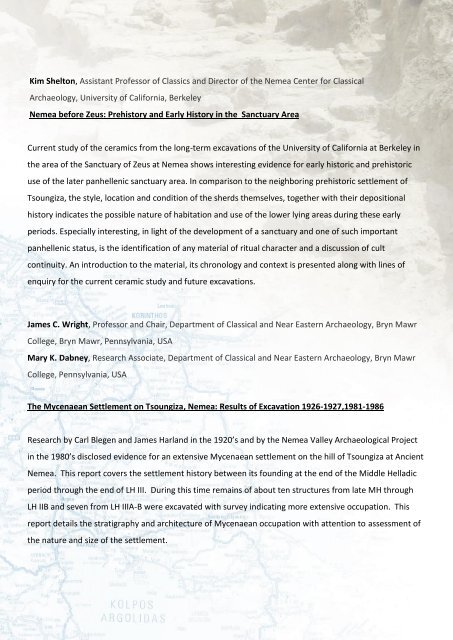ABSTRACTS - The American School of Classical Studies at Athens
ABSTRACTS - The American School of Classical Studies at Athens
ABSTRACTS - The American School of Classical Studies at Athens
You also want an ePaper? Increase the reach of your titles
YUMPU automatically turns print PDFs into web optimized ePapers that Google loves.
Kim Shelton, Assistant Pr<strong>of</strong>essor <strong>of</strong> Classics and Director <strong>of</strong> the Nemea Center for <strong>Classical</strong><br />
Archaeology, University <strong>of</strong> California, Berkeley<br />
Nemea before Zeus: Prehistory and Early History in the Sanctuary Area<br />
Current study <strong>of</strong> the ceramics from the long-term excav<strong>at</strong>ions <strong>of</strong> the University <strong>of</strong> California <strong>at</strong> Berkeley in<br />
the area <strong>of</strong> the Sanctuary <strong>of</strong> Zeus <strong>at</strong> Nemea shows interesting evidence for early historic and prehistoric<br />
use <strong>of</strong> the l<strong>at</strong>er panhellenic sanctuary area. In comparison to the neighboring prehistoric settlement <strong>of</strong><br />
Tsoungiza, the style, loc<strong>at</strong>ion and condition <strong>of</strong> the sherds themselves, together with their depositional<br />
history indic<strong>at</strong>es the possible n<strong>at</strong>ure <strong>of</strong> habit<strong>at</strong>ion and use <strong>of</strong> the lower lying areas during these early<br />
periods. Especially interesting, in light <strong>of</strong> the development <strong>of</strong> a sanctuary and one <strong>of</strong> such important<br />
panhellenic st<strong>at</strong>us, is the identific<strong>at</strong>ion <strong>of</strong> any m<strong>at</strong>erial <strong>of</strong> ritual character and a discussion <strong>of</strong> cult<br />
continuity. An introduction to the m<strong>at</strong>erial, its chronology and context is presented along with lines <strong>of</strong><br />
enquiry for the current ceramic study and future excav<strong>at</strong>ions.<br />
James C. Wright, Pr<strong>of</strong>essor and Chair, Department <strong>of</strong> <strong>Classical</strong> and Near Eastern Archaeology, Bryn Mawr<br />
College, Bryn Mawr, Pennsylvania, USA<br />
Mary K. Dabney, Research Associ<strong>at</strong>e, Department <strong>of</strong> <strong>Classical</strong> and Near Eastern Archaeology, Bryn Mawr<br />
College, Pennsylvania, USA<br />
<strong>The</strong> Mycenaean Settlement on Tsoungiza, Nemea: Results <strong>of</strong> Excav<strong>at</strong>ion 1926-1927,1981-1986<br />
Research by Carl Blegen and James Harland in the 1920’s and by the Nemea Valley Archaeological Project<br />
in the 1980’s disclosed evidence for an extensive Mycenaean settlement on the hill <strong>of</strong> Tsoungiza <strong>at</strong> Ancient<br />
Nemea. This report covers the settlement history between its founding <strong>at</strong> the end <strong>of</strong> the Middle Helladic<br />
period through the end <strong>of</strong> LH III. During this time remains <strong>of</strong> about ten structures from l<strong>at</strong>e MH through<br />
LH IIB and seven from LH IIIA-B were excav<strong>at</strong>ed with survey indic<strong>at</strong>ing more extensive occup<strong>at</strong>ion. This<br />
report details the str<strong>at</strong>igraphy and architecture <strong>of</strong> Mycenaean occup<strong>at</strong>ion with <strong>at</strong>tention to assessment <strong>of</strong><br />
the n<strong>at</strong>ure and size <strong>of</strong> the settlement.

















